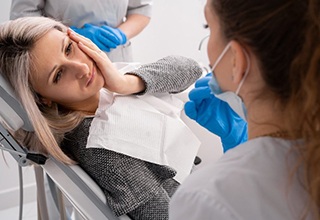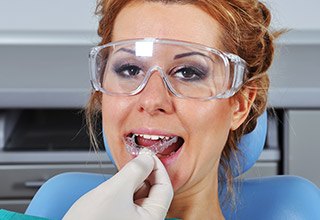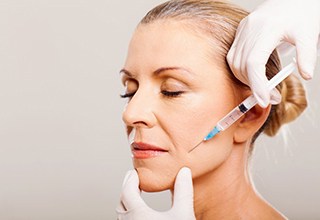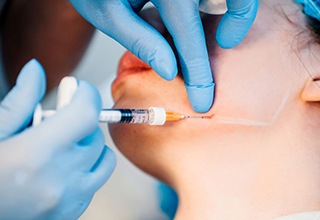TMJ Treatment – Owasso
Headache, Migraine, & Bruxism Relief

The temporomandibular joint (TMJ) is the complicated hinge that attaches the jaw to the skull and gives it its incredible range of movement. Unfortunately, it can become quite painful if its parts fall out of balance. Here’s a brief guide to what TMJ disorder is and how Dr. Voto can treat it. Contact our Owasso dental office today if any of the symptoms listed here sound familiar so we can provide the expert care you need.
Why Choose Dr. Jayson D. Voto for TMJ Treatment?
- Skilled and Compassionate Dentist
- Find Lasting Relief for Persistent Jaw Pain
- Flexible Financing Options Available
What is TMJ Disorder?

Small doesn't always mean simple! The joints located in front of your ears, while not much larger than quarters, are the most used in the human body and responsible for hundreds of movements of the mouth per day. Known as the temporomandibular joints (TMJ), they allow you to open and close your mouth comfortably.
The TMJ can fall out of alignment due to excessive stress caused by vigorous chewing or teeth grinding. This imbalance can cause chronic discomfort of the jaw, neck, head, and back and lead to uneven enamel wear and clicking or popping sounds when the mouth moves.
Symptoms of TMJ Disorder

Symptoms of TMJ dysfunction include:
- Headaches and migraines
- Clicking or popping in the jaw
- Facial, neck, or back pain
- Bruxism (teeth grinding)
- Dizziness and tingling in the extremities
- Earaches
- Ringing in the ears
- Pain when chewing
- Pain behind the eyes
- Difficulty moving the mouth
- Change in bite alignment
Types of TMJ Treatment

At Jayson D. Voto, D.D.S. Family & Cosmetic Dentistry, we can successfully treat TMJ dysfunction and eliminate headache-related pain using safe, effective, and comfortable treatments. During your consultation, our team will discuss your treatment options and help determine which method would be the best way to fulfill your needs. The most suitable treatment for your TMJ disorder depends on the severity of the case and what is causing it.
Occlusal Splint

For most people, an oral appliance that realigns the jaws can remedy the issue and provide relief from nagging symptoms. This device will help protect the teeth from grinding while shifting the jaw into a more forward position, which will help the joints align comfortably and relieve persistent TMJ pain.
BOTOX for TMJ Treatment

While BOTOX is primarily known for its cosmetic benefits it also has some very useful medical applications. For example, it can relax tense muscles throughout the face and jaw. In turn, you may experience fast and powerful relief from the pain associated with TMJ disorder (TMD). BOTOX therapy can be an excellent complement for other treatments, and with periodic injections, it can be a long-term solution.
What Is BOTOX?

BOTOX is the brand name of a diluted form of botulinum toxin. Although the word “toxin” might sound a bit scary, BOTOX actually has a track record of safety and effectiveness. When it is strategically injected into the facial muscles, it limits their ability to move. Not only does this smooth out the skin on top of those muscles (hence the cosmetic benefits of BOTOX), but it also relieves muscle tension and pain. In turn, this can allow overworked jaw joints to relax.
BOTOX can be administered quickly and with minimal discomfort. Within 7 – 10 days, you might notice a significant reduction in your TMD symptoms.
Are You a Good Candidate for BOTOX for TMJ Treatment?

BOTOX may be an option for anyone who is struggling with symptoms of TMD, including:
- A painful and tender jaw
- Limited jaw movement or the sensation of lockjaw
- Bite changes
- Difficulty while chewing
- Clicking and popping in the jaw
- Headaches and migraines
BOTOX may be particularly helpful for individuals who experience bruxism (teeth grinding and clenching). This habit can place a lot of stress on the jaw and surrounding tissue. With the help of BOTOX, bruxism may be greatly reduced or even eliminated.
How Can BOTOX Treat TMJ Disorder?

BOTOX works by relaxing the tense muscles that can cause pain and discomfort in individuals with TMJ disorder. In fact, multiple studies have found it to be an effective TMJ treatment. One research group even found that BOTOX improved symptoms in 90% of participants.
However, keep in mind that it does not address the root cause of TMD. For this reason, you may need to use it alongside other therapies, such as an occlusal splint, to experience the best, longest-lasting results. Also, BOTOX tends to wear off after several months. You may choose to return for additional injections, but once the underlying cause of your discomfort has been taken care of, additional BOTOX might not be necessary.
